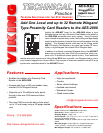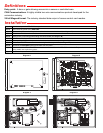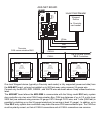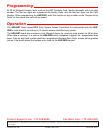
Due to the dynamic nature of the product design, the information contained in this document is subject to change without notice. Viking Electronics, and its affiliates and/or
subsidiaries assume no responsibility for errors and omissions contained in this information. Revisions of this document or new editions of it may be issued to incorporate
such changes.
Fax Back Doc 196
ZF301740 Rev 1
Printed in the U.S.A.
P
P
r
r
o
o
d
d
u
u
c
c
t
t
S
S
u
u
p
p
p
p
o
o
r
r
t
t
L
L
i
i
n
n
e
e
.
.
.
.
.
.
7
7
1
1
5
5
.
.
3
3
8
8
6
6
.
.
8
8
6
6
6
6
6
6
F
F
a
a
x
x
B
B
a
a
c
c
k
k
L
L
i
i
n
n
e
e
.
.
.
.
.
.
7
7
1
1
5
5
.
.
3
3
8
8
6
6
.
.
4
4
3
3
4
4
5
5
P
P
r
r
o
o
g
g
r
r
a
a
m
m
m
m
i
i
n
n
g
g
All 26 bit Wiegand Access Cards, such as the HID Proximity Card, identify themselfs with a six digit
number. The first two digits are considered the Facility Code, and the last four digits are the Card
Number. When programming the AES-2000, enter this unique six digit number as the "Keyless Entry
Code" for the person the card will be issued.
O
O
p
p
e
e
r
r
a
a
t
t
i
i
o
o
n
n
The AES-NET board allows ES-3 Entry System Access Controllers to communicate with the AES-
2000's main board to provide up to 32 remote access controlled entry points.
The AES-NET board also monitors a local Wiegand device (ie, proximity card reader) for 26 bit data.
When data is received, it is sent to the AES-2000 which compares it against the programmed data
base. If the six digit card number matches a programmed Keyless Entry Code, access will be granted
just as if the tenant dialed the keyless entry code on the AES-2000 keypad.






